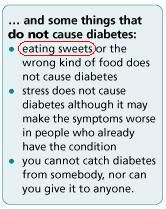Fun Fact of the Day (#87256)
 Diabetes mellitus is a medical disorder characterized by varying or persistent hyperglycemia (elevated blood sugar levels), especially after eating. All types of diabetes mellitus share similar symptoms and complications at advanced stages. Hyperglycemia itself can lead to dehydration and ketoacidosis. Longer-term complications include cardiovascular disease (doubled risk), chronic renal failure (it is the main cause for dialysis), retinal damage which can lead to blindness, nerve damage which can lead to erectile dysfunction (impotence), gangrene with risk of amputation of toes, feet, and even legs. Serious complications are much less common in people who control their blood sugars well with lifestyle and medications.
Diabetes mellitus is a medical disorder characterized by varying or persistent hyperglycemia (elevated blood sugar levels), especially after eating. All types of diabetes mellitus share similar symptoms and complications at advanced stages. Hyperglycemia itself can lead to dehydration and ketoacidosis. Longer-term complications include cardiovascular disease (doubled risk), chronic renal failure (it is the main cause for dialysis), retinal damage which can lead to blindness, nerve damage which can lead to erectile dysfunction (impotence), gangrene with risk of amputation of toes, feet, and even legs. Serious complications are much less common in people who control their blood sugars well with lifestyle and medications.Most of the carbohydrates in food are rapidly converted to glucose, the principal sugar in blood. Insulin is produced by beta cells in the pancreas in response to rising levels of glucose in the blood, as occurs after a meal. Insulin makes it possible for most body tissues to remove glucose from the blood for use as fuel, for conversion to other needed molecules, or for storage. Insulin is also the principal control signal for conversion of glucose (the basic sugar unit) to glycogen for storage in liver and muscle cells. Lowered insulin levels result in the reverse conversion of glycogen to glucose when glucose levels fall — though only glucose so produced in the liver goes into the blood. Higher insulin levels increase many anabolic ("building up") processes such as cell growth, cellular protein synthesis, and fat storage. Insulin is the principal signal in converting many of the bidirectional processes of metabolism from a catabolic to an anabolic direction.
Type 1 diabetes develops when the insulin-producing cells in the pancreas have been destroyed. Nobody knows for sure why these cells have been damaged but the most likely cause is an abnormal reaction of the body to the cells. This may be triggered by a viral or other infection. This type of diabetes generally affects younger people. Both sexes are affected equally.
Type 2 develops when the body can still make some insulin, but not enough, or when the insulin that is produced does not work properly (known as insulin resistance). In most cases this is linked with being overweight. This type of diabetes usually appears in people over the age of 40, though in South Asian and African-Caribbean people it often appears after the age of 25.
Sweets do not cause diabetes.
Sayang... kala ko me katarungan dito sa mundo, hehe...
(wala lang, naisip ko lang bigla to... saka na ako magu-update... katamaran!)



0 Comments:
Post a Comment
<< Home